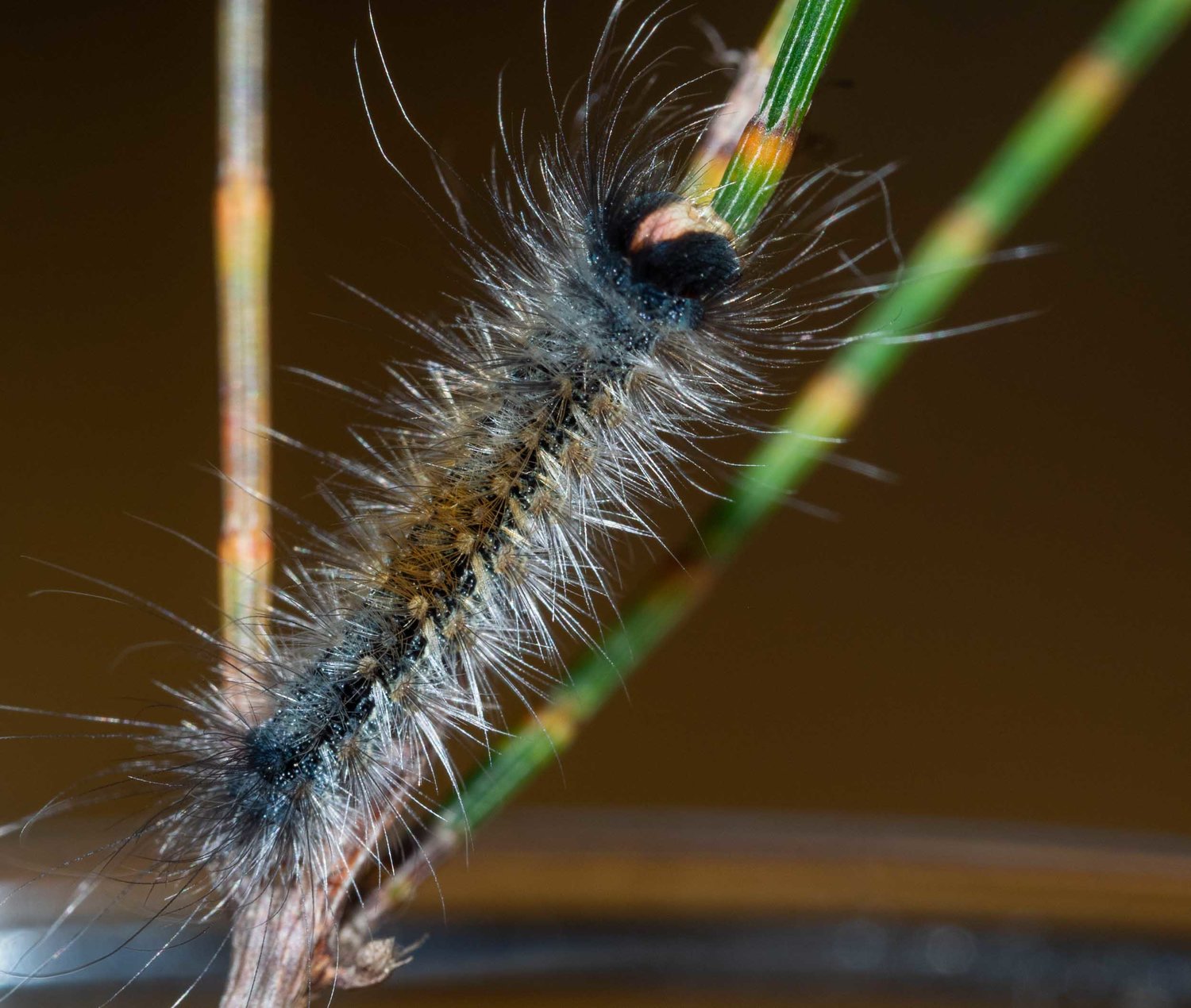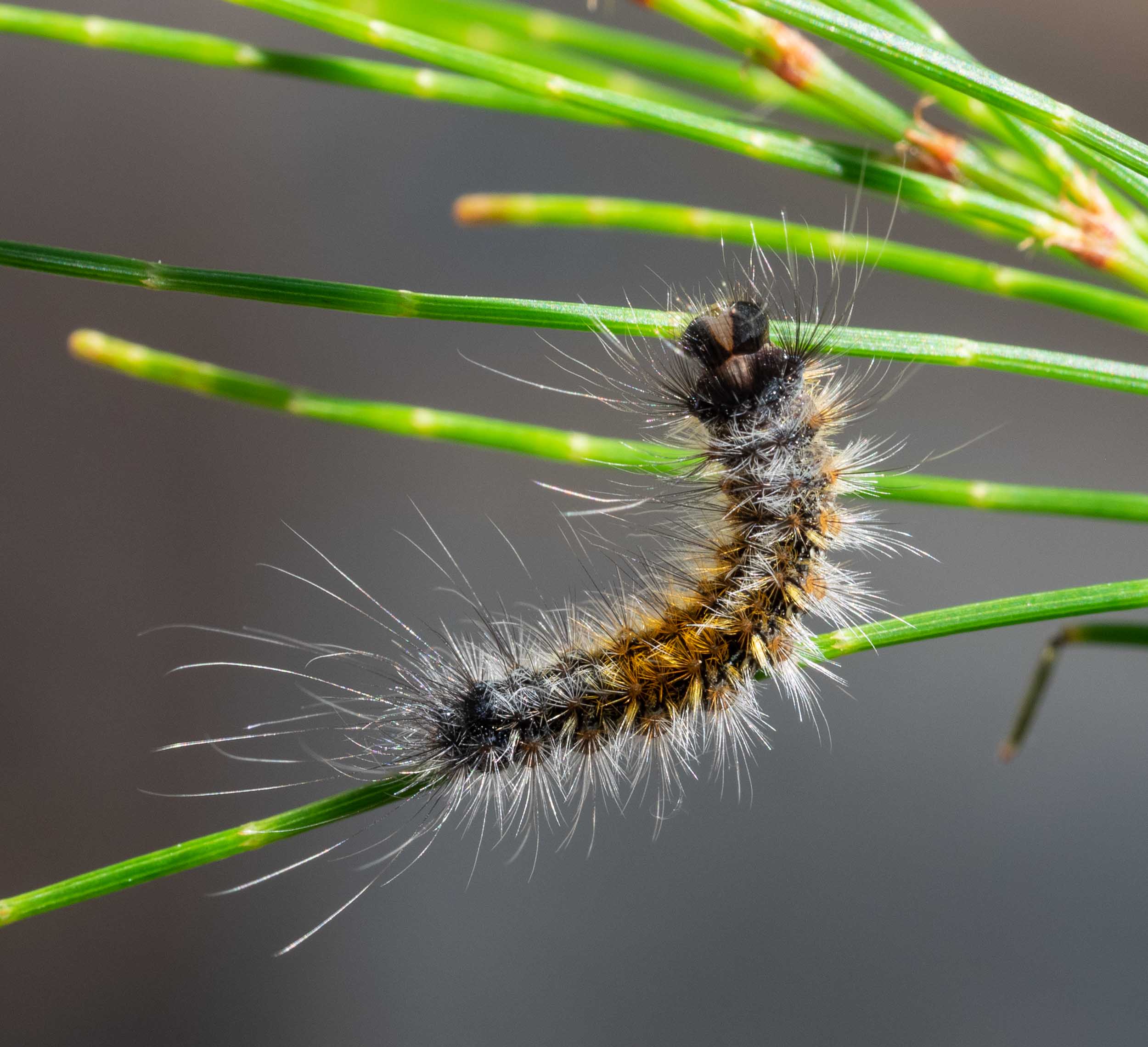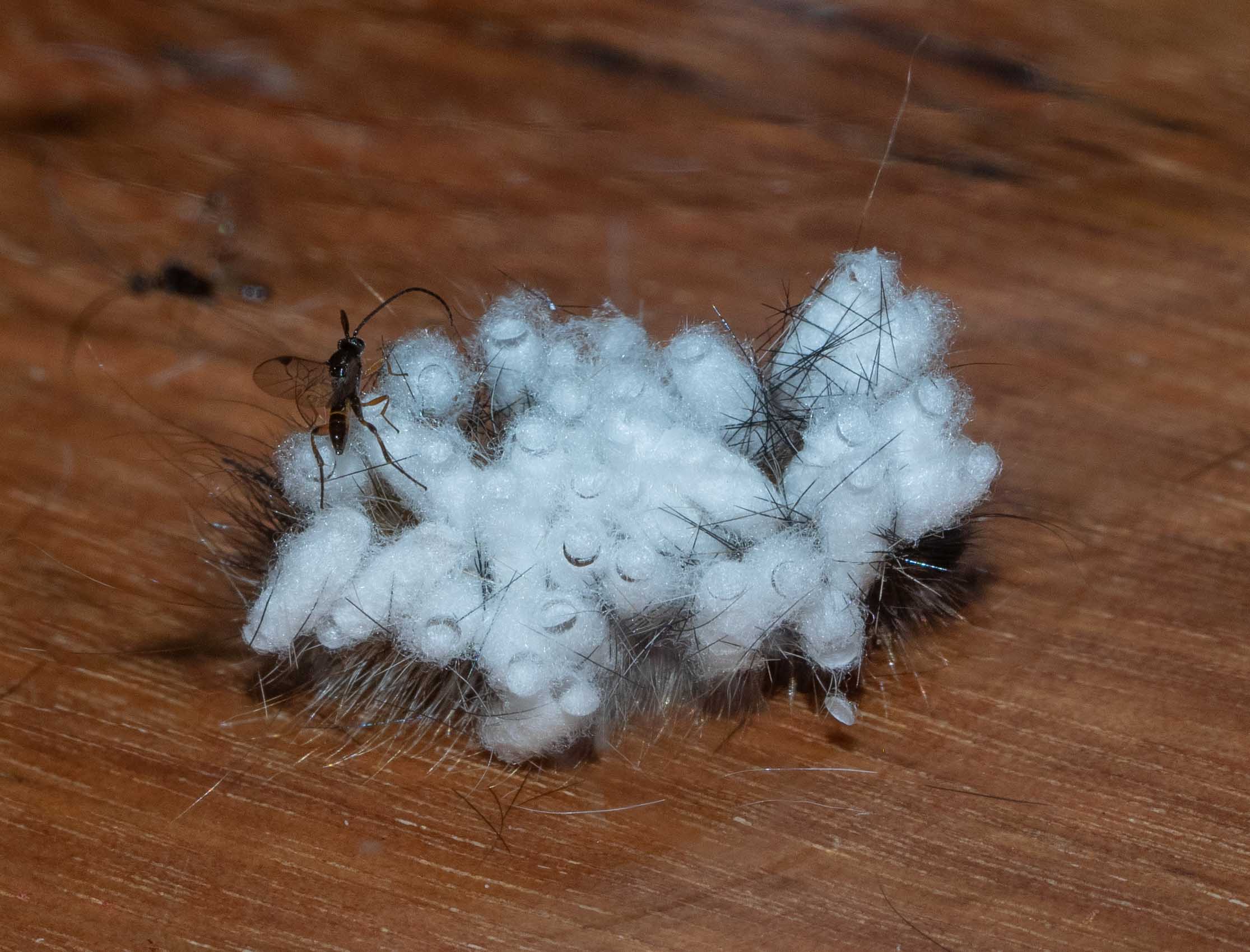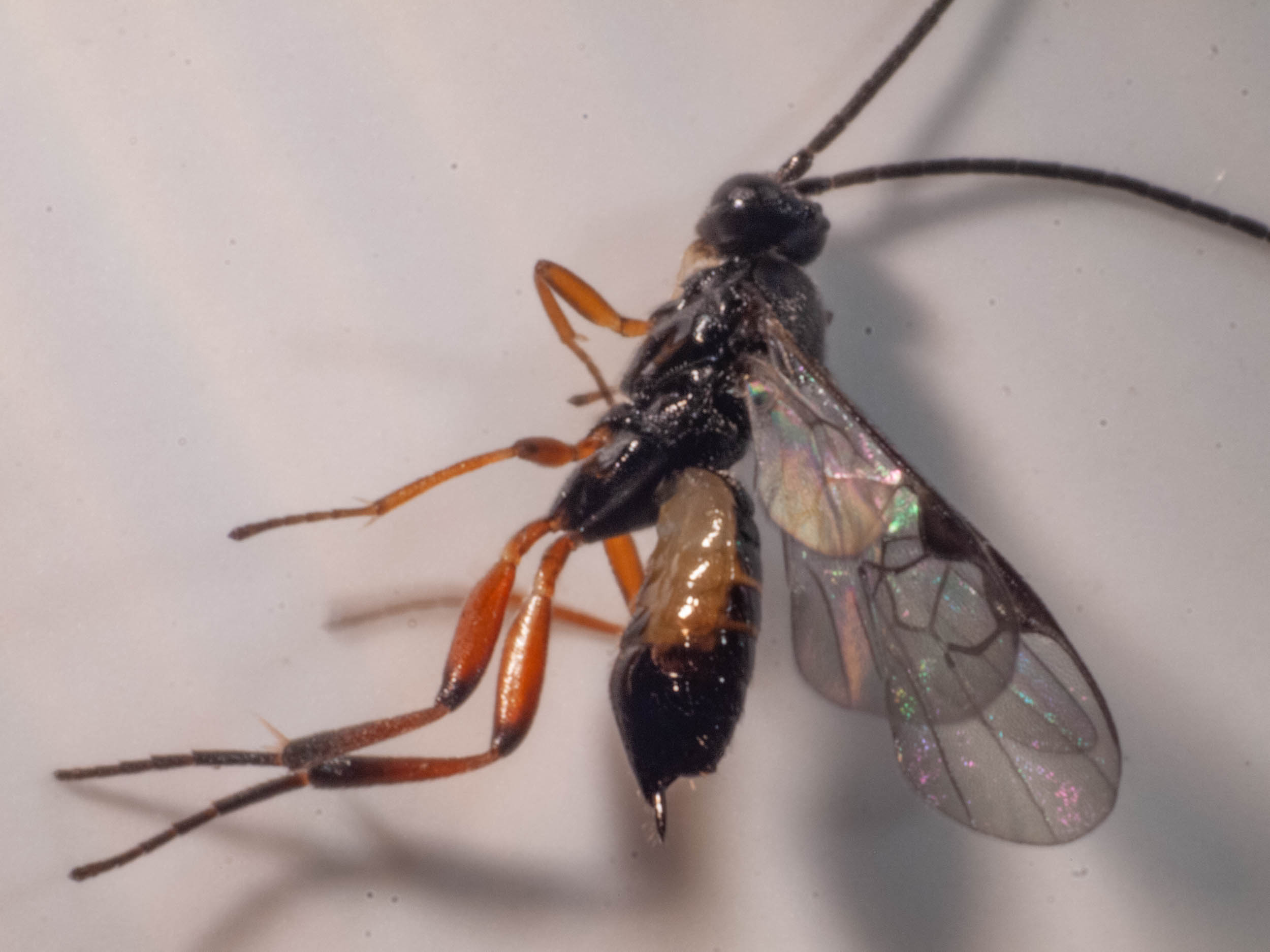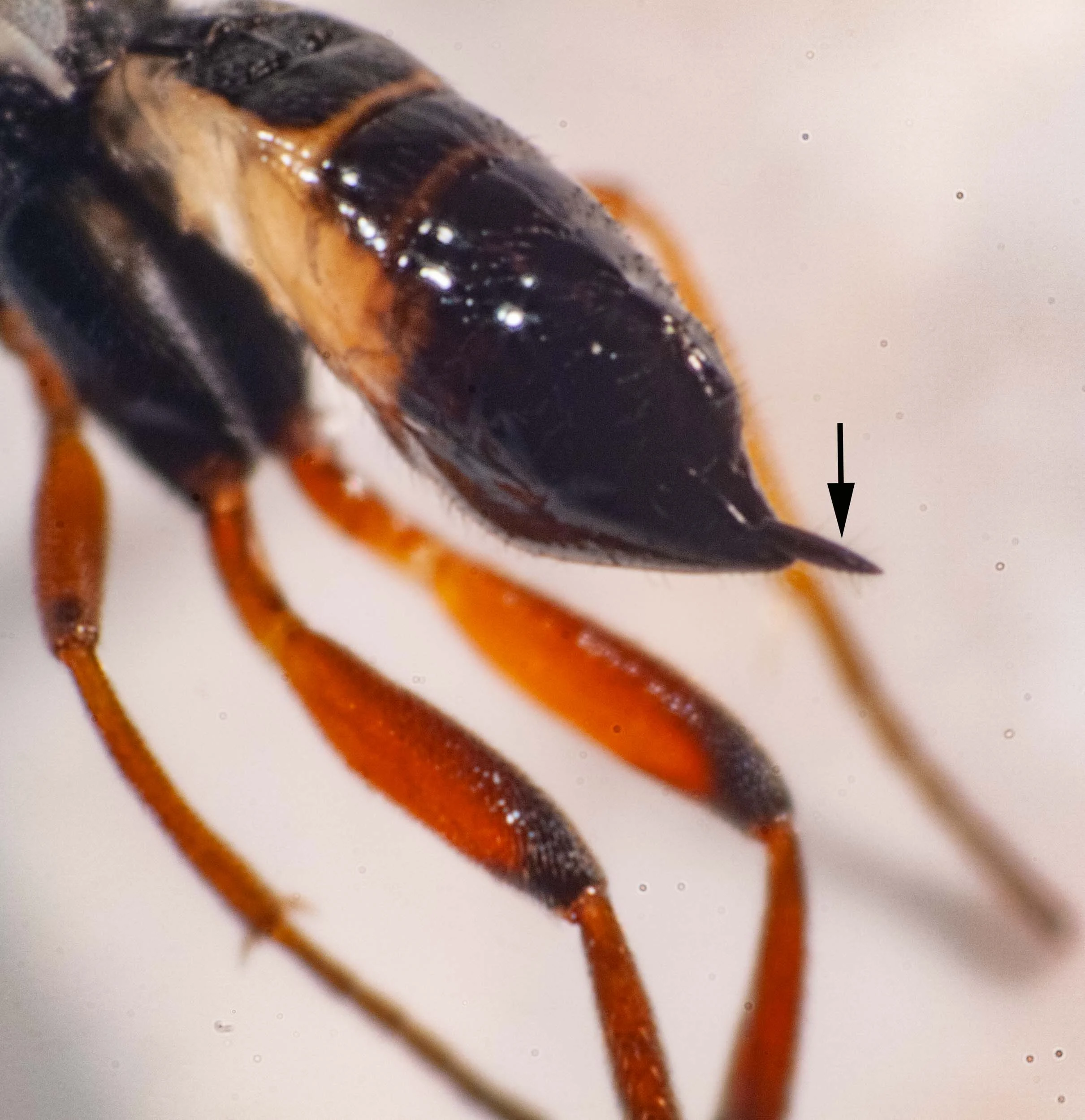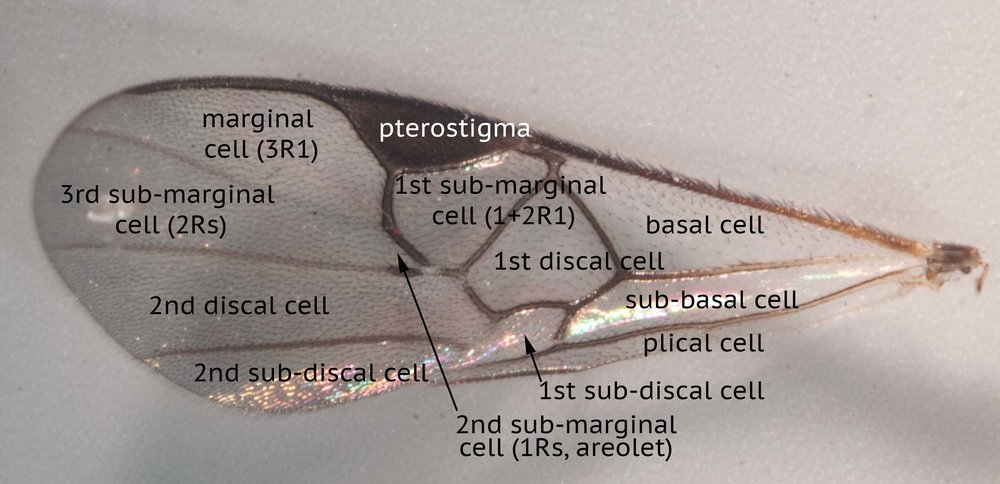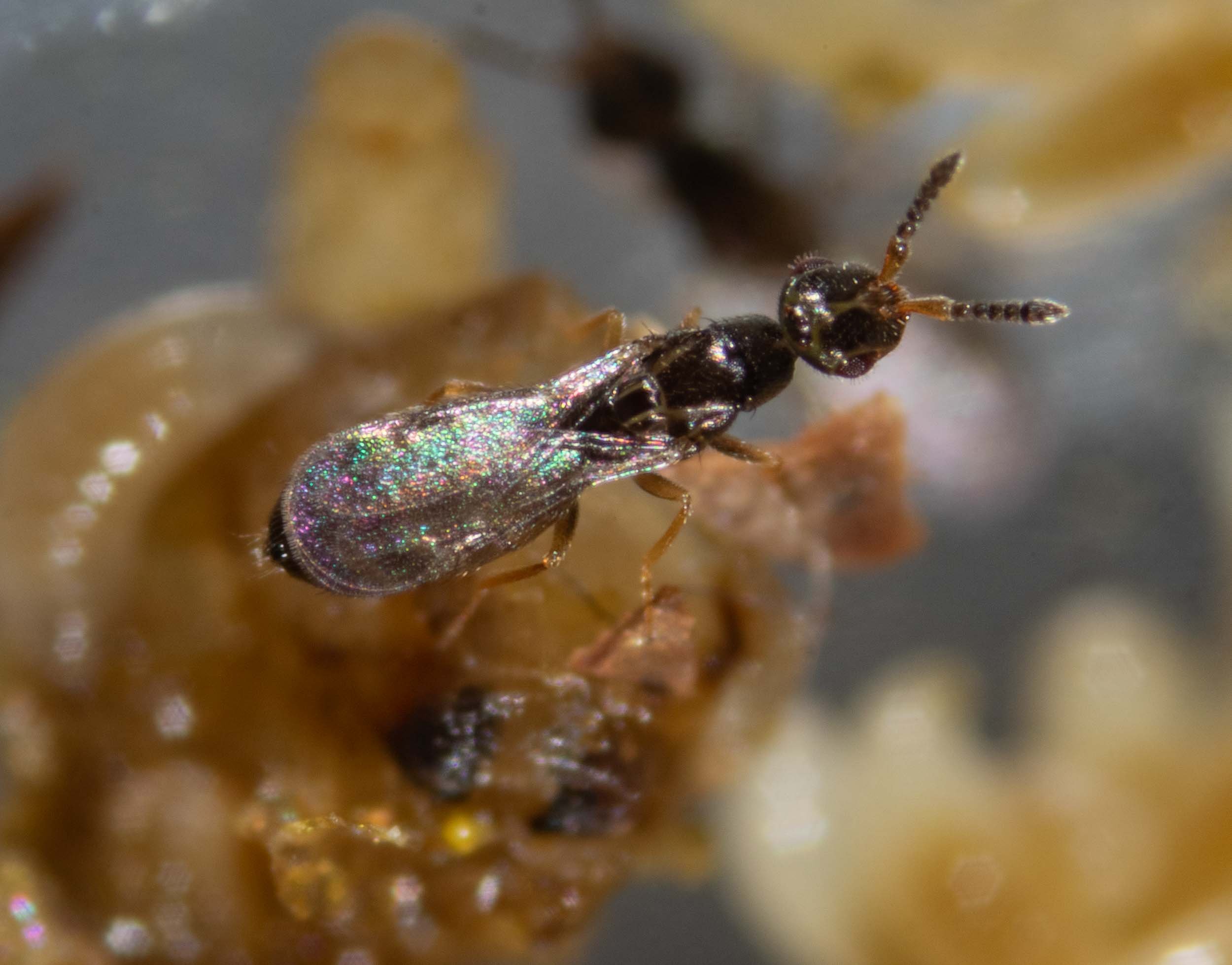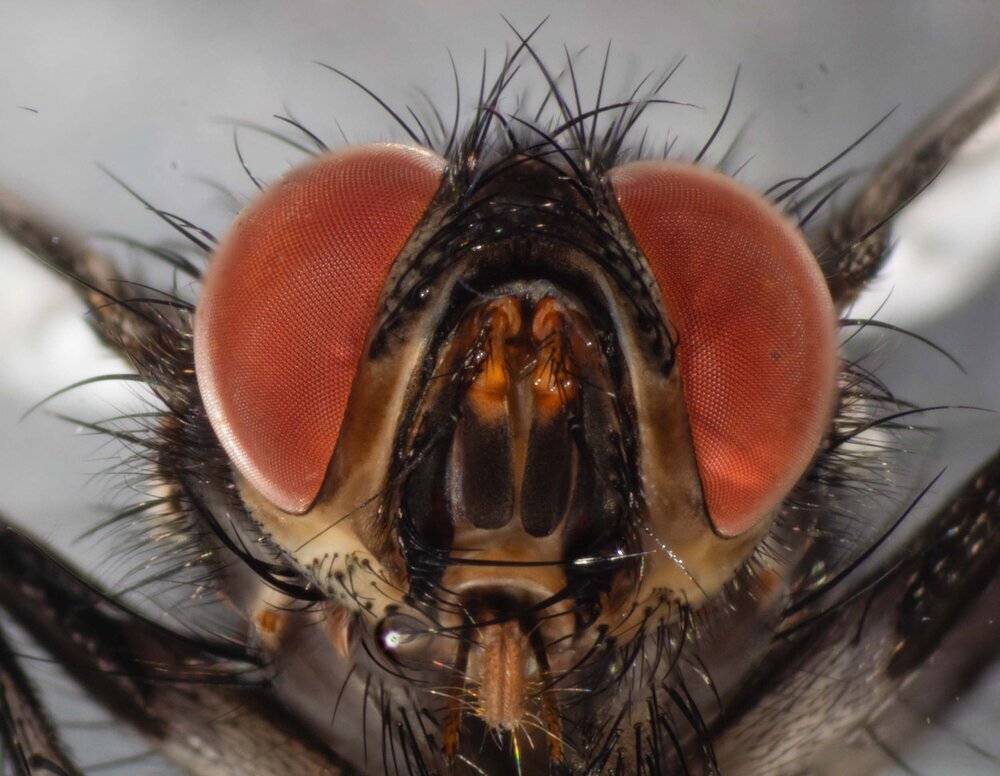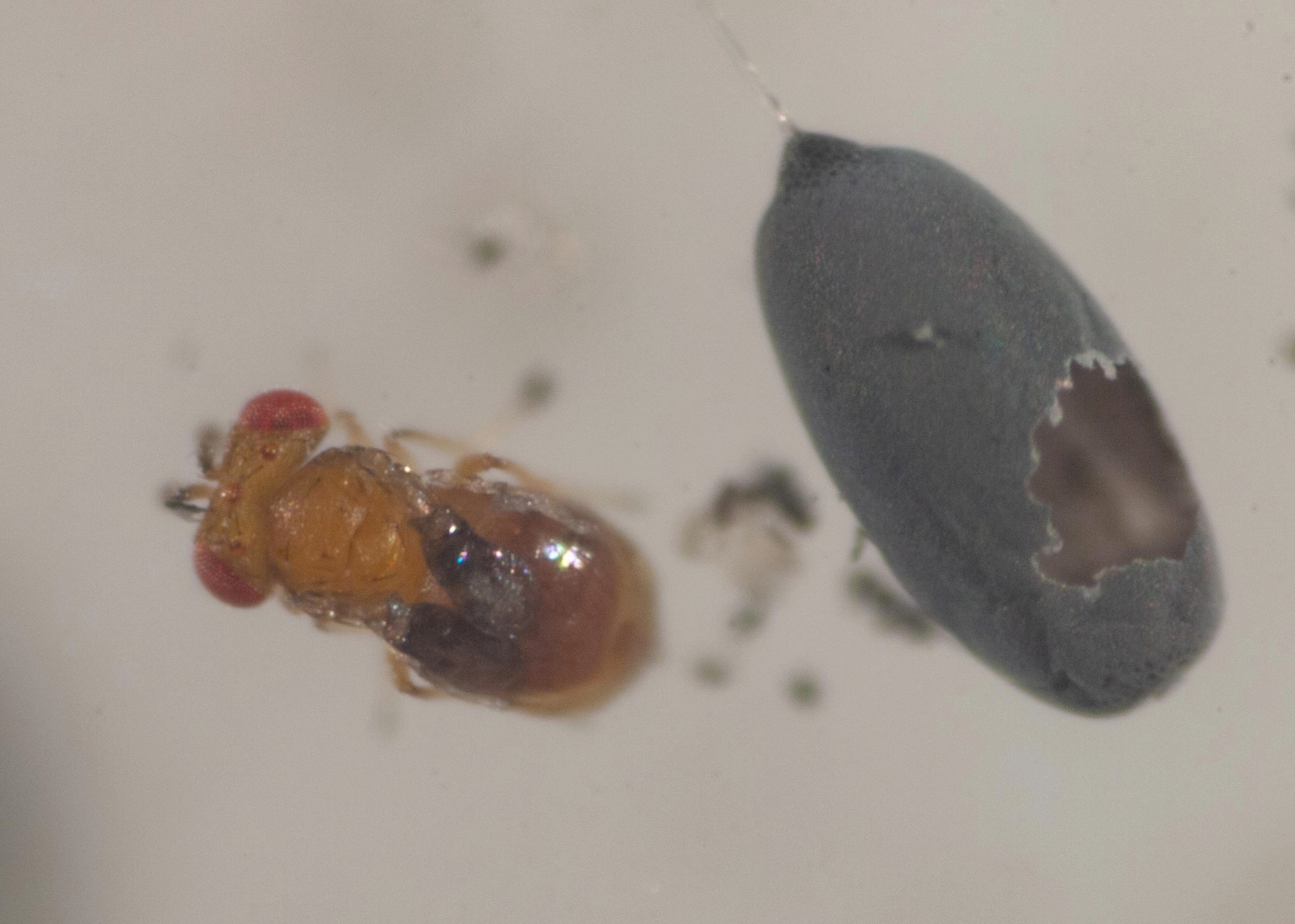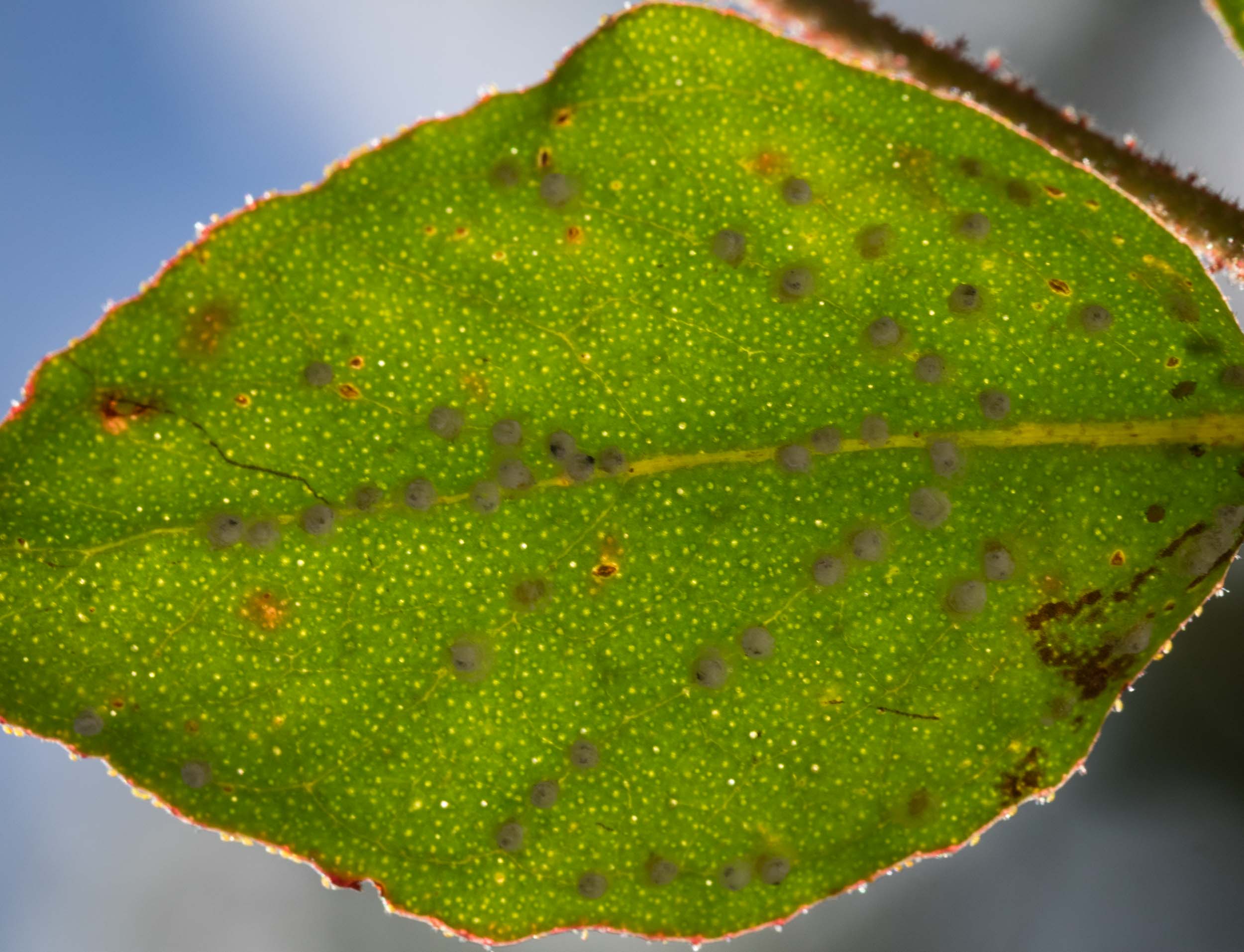Rearing wasps ... by accident
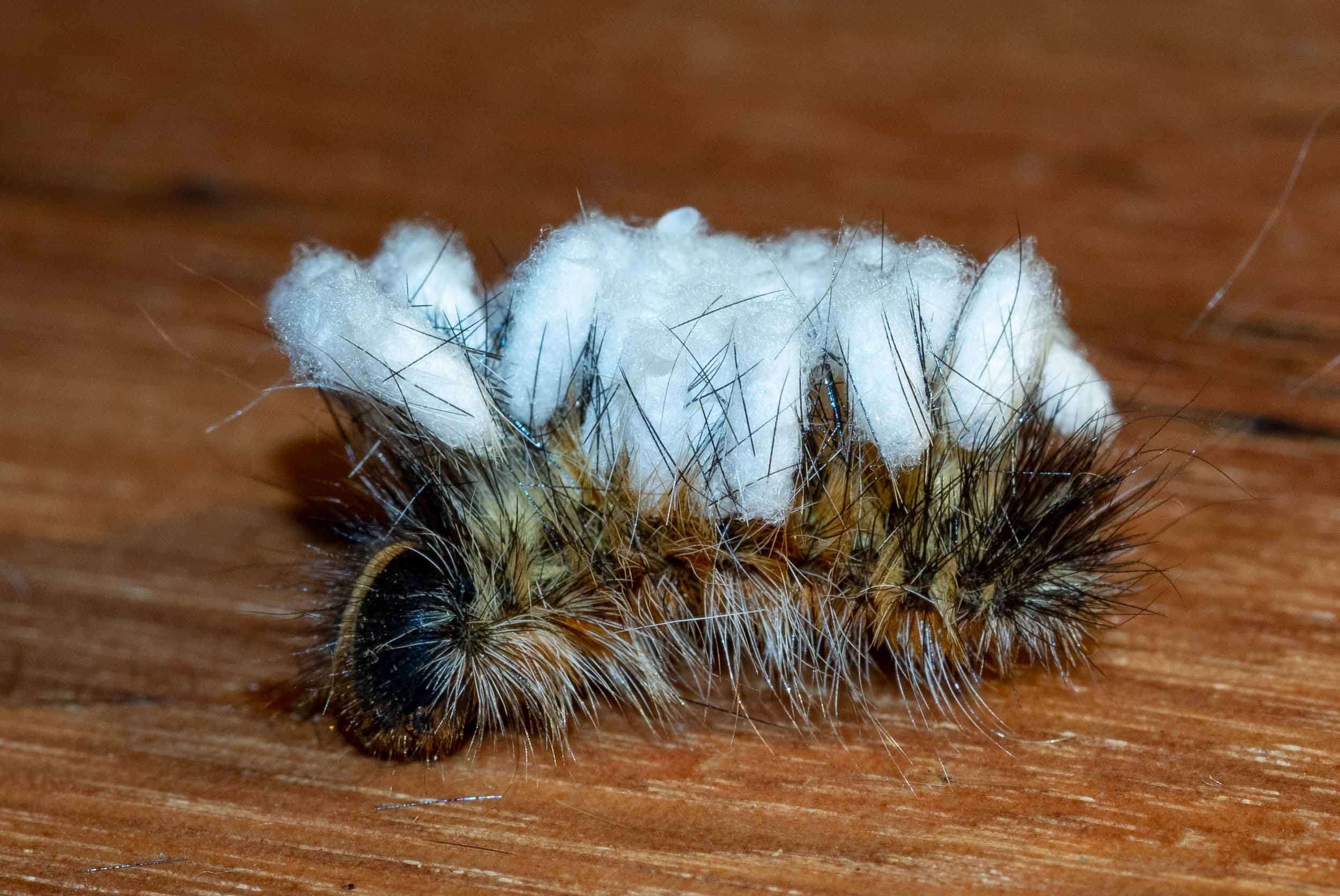
Identification of a moth species from its larva can be challenging. The caterpillars of only a small fraction of the >10,000 known species of Australian moths have been described and photographed. Furthermore, the larvae of different species in the same family can be very similar in appearance.
So when we collect a caterpillar that we have not previously seen, we usually try to rear it through to the adult stage to discover or confirm its identity. Thus began this story…
The She-oak buddy
On 8th February this year, Kerri found a caterpillar on a Black She-oak (Allocasuarina littoralis) tree. It was unfamiliar, so it went straight into the ‘buddy tank’.
The plant on which we found this guy was clearly its preferred food plant as it munched away happily on Allocasuarina cuttings over the next week and grew apace.
Then a month later - on 7th March - its behaviour changed. It became restless, wandering around the tank before finally resting on the floor.
Was it about to pupate, we wondered?
Buddy’s fate
On 16th March the caterpillar still lay motionless on the bottom of the tank. It was covered in a white fuzzy material, which we assumed was a fungus growing on its corpse.
Closer inspection revealed that this fuzziness was actually a collection of silken cocoons, neatly arranged on the back of the caterpillar.
While moving the caterpillar to get a closer look, one of the cocoons lost its contents.
This was clearly a pupa of some sort, but what type of insect? The creature, whatever it was, immediately began to spin a replacement silk cocoon.
Kerri placed a glass over the dead caterpillar to ensure that whatever was developing in the other cocoons didn’t escape when they emerged. We didn’t have to wait too long to discover what ‘they’ were.
Identity of the pupae revealed
At 6pm on 24th March, Kerri spied two tiny wasps - about 3mm long - crawling up the inside of the glass. So we now knew we were dealing with a wasp endoparasitoid.
By the next morning several more wasps had emerged from their cocoons. Two days later we had a collection of 30 young wasps - the complete brood - inside the glass. Close examination of the cocoons revealed the little trapdoors used by the wasps to make their escape.
20 of these wasps were clearly females, as they possessed an ovipositor, shown in the images below. The other 10 lacked this organ, so were males.
What sort of wasp?
Identification of wasps, like moth larvae, is a non-trivial process. They belong to the order Hymenoptera, which is one of the four mega-diverse orders of insects. There are 57 families of Australian wasps (63 if you include the sawflies). So even getting to the family level can be challenging.
Flicking through the tome Insects of Australia (Ref. 1), I chanced across a drawing of a wasp that looked very similar to our parasite.
Fig. 42.20E from Ref. 1
This is a member of the family Braconidae, sub-family Microgastrinae, which according to Insects of Australia, “are endoparasites on larvae of Lepidoptera” - tick.
Insects of Australia continues… “oviposition is into the egg or early larval instar”, “pupation takes place outside the host, gregarious species often spinning their cocoons together in a silken web” - tick.
While at this stage I hadn’t worked assiduously through the relevant key, I was willing to take a punt that I’d got the subfamily Microgastrinae right. The wing morphology seemed to fit and the antennae appeared to have the requisite number of segments for this group of wasps.
Which genus of microgastrine wasp?
So where to next? The Australian Faunal Directory came to the rescue, guiding me to a paper (Ref. 2) with a key to the genera in the subfamily Microgastrinae. This is a large group with 100+ described species, which represent less than 20% of its true size.
Time to get serious. After working through the key with a number of euthanased females in hand, I was pretty confident that I’d found the genus to which they belonged - Miropotes.
view of head
This process demanded a close examination of the wings, ovipositor, head and various other bits of the body.
This involved a few hours study of the creature under the dissecting microscope and images thereof on the computer screen.
Ref. 2 also provided some interesting background about microgastrine wasps. This is one of the largest subfamilies in the Braconidae, with around 1,300 described species worldwide.
Being endoparasites of lepidopteran larvae, these wasps are important agents for biological control of agricultural pests. They have been used to control lightbrown apple moth, potato moth, cabbage moth, budworms, armyworms and cutworms.
In a natural environment, they undoubtedly help to maintain the ecological balance - keeping populations of various moth larvae in check.
Back to the beginning - what is the caterpillar?
This story began with a caterpillar. This seems to have been forgotten along the way.
While we have learnt a lot about wasp biology and taxonomy, we still can’t answer our original question - what species of moth would this larva have developed into had it not been parasitised by a female microgastrine wasp?
So at this stage, the puzzle remains unsolved! However, Erinn has also offered to do DNA barcoding on the dead caterpillar in which my wasps developed as larvae. So we may know the identity of the caterpillar before long as well.
Erinn hasn’t yet been able to identify the moth species but I’ve suggested a good candidate is Anthela connexa. This species is reported to feed on casuarina and an image on Don Herbison-Evan’s website is similar to our caterpillar. Luka is attempting to raise 3 larvae we collected on the same casuarina bush through to adulthood.
References
“The Insects of Australia”. (1991) 2nd Ed. CSIRO Melbourne University Press.
Austin, A.D. and Dangerfield, P.C. (1992) “Synopsis of Australian Microgastrinae (Hymenoptera: Braconidae), with a key to genera and description of new taxa”. Invertebrate Taxonomy 6: 1-76.
I’ve also published this story, with further detail, as an Occasional Paper on the Atlas of Life website … Uncovering Hidden Wasps
UPDATES
1/5/19 … NEWSFLASH!
An expert in microgastrine wasps, Dr. Erinn Fagan-Jeffries, from the Department of Ecology and Evolutionary Biology, University of Adelaide has informed me that my identification of this wasp as a Miropotes sp. is incorrect. As you can see from my photo of the forewing above, the cell I have labelled 2nd sub-marginal cell or areolet doesn’t actually exist! The areolet is one of the diagnostic characters of Miropotes.
Erinn has kindly offered to do DNA barcoding on my wasps to identify the species. I can’t wait to get the answer! (Thanks also to a reader of my post who alerted me to Erinn’s research).
27/6/19
Erinn has now confirmed her initial identification of this wasp - based on DNA barcoding - as a new species of the genus Cotesia. Worldwide, this is the largest genus of microgastrine wasps and is the second largest Australian genus. According to Austin and Dangerfield (1992), Cotesia “can be easily recognised by the absence of an areolet, short inflexible hypopygium and short ovipositor, parallel-sided or posteriorly broadened T1, and large rectangular T2.” - features which are all evident in my wasp.
Erinn will be including this new species in a revision she is currently preparing of Cotesia. She has also asked me for a suggestion for a name of this new species. I’m leaning towards “Cotesia wonboyn” or whatever the correct Latin form of wonboyn is.
2/7/19
Seems my new little wasp has captured people’s imagination! This morning Simon Lauder from ABC Radio South East interviewed both myself and Dr. Erinn Fagan-Jeffries about my discovery of this new species of wasp. During her interview, Erinn confirmed that she will use my suggestion of a name for the new species - Cotesia wonboynensis - “The wasp from Wonboyn” … or the Wonboyn Wasp, as Simon called it!
This is a recording of my interview with Simon.
Then in the afternoon, I was interviewed by Paula Kruger from ABC Radio Canberra.
Erinn has said she’ll let me know when her paper describing the Cotesia revision has been accepted. The “Wonboyn Wasp” will then be an official new species!

